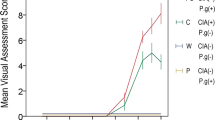Abstract
The common side effects associated with the use of prostaglandins in newborn infants include apnoea, hyperthermia, diarrhoea, skin flushing and oedema. Periosteal reaction or cortical thickening of the bones, also known as cortical hyperostosis, is associated with a prolonged use of prostaglandins. This is a radiological diagnosis; therefore, its occurrence is most likely underestimated. We describe an infant who developed cortical hyperostosis simulating osteomyelitis with elevated alkaline phosphatase. The radiologic changes were initially attributed to congenital syphilis. This occurred after a prolonged infusion of prostaglandin E1 for a cyanotic congenital heart disease.
This is a preview of subscription content, access via your institution
Access options
Subscribe to this journal
Receive 12 print issues and online access
$259.00 per year
only $21.58 per issue
Buy this article
- Purchase on Springer Link
- Instant access to full article PDF
Prices may be subject to local taxes which are calculated during checkout


Similar content being viewed by others
References
Donahoo JS, Roland JM, Kan J, Gardner TJ, Kidd BS . Prostaglandin E1 as an adjunct to emergency cardiac operation in neonates. J Thorac Cardiovasc Surg 1981;81:227–231.
Babyn P, Peled N, Manson D, Dagan O, Silver MM, Koren G . Radiologic features of gastric outlet obstruction in infants after long-term prostaglandin administration. Pediatr Radiol 1995;25:41–44.
Jureidini S, Chase NA, Alpert BS, Vanderzalm T, Sheneflet RE . Soft tissue swelling in two neonates during prostaglandin E1 therapy. Pediatr Cardiol 1986;7:157–160.
Kaufman MB, El-Chaar GM . Bone and tissue changes following prostaglandin therapy in neonates. Ann Pharmacother 1996;30:269–277.
Jorgensen HR, Svanholm H, Host A . Bone formation induced in an infant by systemic prostaglandin-E2 administration. Acta Orthop Scand 1988;59:464–466.
Nadroo AM, Shringari S, Garg M, al-Sowailem AM . Prostaglandin induced cortical hyperostosis in neonates with cyanotic heart disease. J Perinat Med 2000;28:447–452.
Kalloghlian AK, Frayha HH, deMoor MM . Cortical hyperostosis simulating osteomyelitis after short-term prostaglandin E1 infusion. Eur J Pediatr 1996;155:173–174.
Woo K, Emery J, Peabody J . Cortical hyperostosis: a complication of prolonged prostaglandin infusion in infants awaiting cardiac transplantation. Pediatrics 1994;93:417–420.
Host A, Halken S, Andersen Jr PE . Reversibility of cortical hyperostosis following long-term prostaglandin E1 therapy in infants with ductus-dependent congenital heart disease. Pediatr Radiol 1988;18:149–153.
Silverman FN, Kuhn JP . Caffey's Pediatric X-ray Diagnosis: An Intergrated Imaging Approach. St. Louis: CV Mosby; 1993. p. 1855–1867.
Author information
Authors and Affiliations
Rights and permissions
About this article
Cite this article
Velaphi, S., Cilliers, A., Beckh-Arnold, E. et al. Cortical Hyperostosis in an Infant on Prolonged Prostaglandin Infusion: Case Report and Literature Review. J Perinatol 24, 263–265 (2004). https://doi.org/10.1038/sj.jp.7211050
Published:
Issue Date:
DOI: https://doi.org/10.1038/sj.jp.7211050
This article is cited by
-
Spontaneous dissection of the arterial duct during continuous infusion of prostaglandin E1 in a neonate with aortic arch interruption
Journal of Echocardiography (2013)


